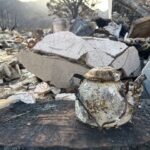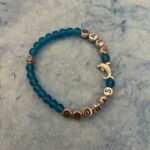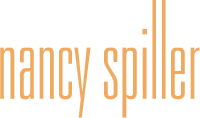April 13, 2025

While prepping for my upcoming Words & Pictures: Weekend Workshop in Creative Writing From Visual Art (May 3 & 4) I got an ekphrastic (writing to visuals) piece of my own accepted by the Windward Review, to be published this September. The literary journal, which I’d previously published in, invited me this February to respond to their prompt, suggesting use of ekphrastic techniques to explore the concept of time. I had plenty of material to work with, considering we’d lost our home in January to the Palisades Fire. There were photos of our life there, lost art work I’d made or we’d collected, and then there was the video, an inventory my husband had taken years before for insurance purposes, in case something like this happened. And so it did. It was a thumb drive held in a Bank of America safe deposit box. Because that branch was also destroyed in the fire, it took us more than a month for B of A to even let us know if the box had survived. Then it took more time before we could get an appointment to visit the location they’d moved it to.
What a relief to discover the thumb drive was viable, the video playable! What a surprise, as well, to find I couldn’t bring myself to watch it. It was just too painful. I need to watch it to make the inventory list of everything we lost for insurance to payout our policy in full. I have three years to do it. Up until downloading that video to the laptop I evacuated with and hitting play, I’d been powering through a post disaster marathon with its multitude of moving parts. But I couldn’t watch the video once my husband, the cameraman, walked through our front door to scan the contents of that house we so loved. All the things in it, a lifetime of gatherings, and the lives we’d lived there were gone. Reduced to rubble and memories.
I will watch it, eventually. The list will get done. Meanwhile, the piece, titled The Hungry Ghost, will be out in September.
Now, to that other thing I came here to write today:
Until It Wasn’t Anymore:
In case you didn’t know, I’ll share the sad news: we lost our coastal canyon home of 18 years to the Palisades Fire. Yes, we had decorative wood siding on our buildings, that’s why we were called the Upper Woodies. Yes, we were living at the edge of the increasingly flammable wilderness. Yes, we were kindling just waiting for the flames. But truly, I could not have continued living in Los Angeles if we had not been living there. Call me an urban hillbilly, but I had to be that close to nature for my sanity and equilibrium. I also had to work at home and this was the home I could work in. I wrote and published two books there, I illustrated one, I painted and made art that I shared with the world. I needed the trees and open spaces to survive both physically and psychically. I once remarked, back in the late ’90s, on how disconnected Los Angeles was from nature. That was until we moved to the Westside.
For 20 years prior we lived in an older, single family home in a more congested and densely populated neighborhood. Towards the end of that tenure, I had begun to fantasize about the relief I’d feel if that highly problematic house burned. We had a true love hate relationship with it, and my days were variously soaring with delight at the views, the quirky charm (before the quandary column took over), the gorgeous garden we’d planted, and the immediate aftermath of the one year we spent (it was just supposed to take a few months…) on a wonderful architect-led remodel. We were totally sold on that being our Dream House and recommitting to the neighborhood, I kept telling myself and the neighbors, through gritted teeth. What I couldn’t tell them or even myself was I wanted out, but didn’t know how to do that. It was a failure of imagination that was sucking the life out of me. Then, after the gorgeous, expensive and lengthy remodel, the house demanded more work, and more of our time and money. Big Time. I was walking around actively loathing my life there. I couldn’t get anything done beyond maintenance projects and dinner parties–my effort to cut through the social isolation I felt living in a single family, hillside neighborhood, or at least that one. It was time to go.
I’d first visited the Palisades Highlands more than a decade before we began looking there in early 2006. It was night time and our writing group that came from all corners of the L.A. sprawl, were meeting at a member’s house on Michael Lane, just up the road from where we ultimately bought. Their townhome faced a mountainside of open land across the street. I considered the place new construction, built sometime in the 70s, versus our elderly hillside abode, built in 1924. I filed it in the back of my mind as an interesting place to revisit should we ever choose to divorce our South Glendale recycling project.
Then, around 2005, when I’d really had it up to my eyeballs with the “charming” house’s demands, I lunched with a Westside woman friend who I enjoyed a lot but was never really clear on where she lived–I’d just never asked. And who even visited the Westside anymore, what with the increasing challenges of traffic getting back to the East. Over that lunch I described to her the canyon I’d kept in the back of my mind. “That’s where we live,” she said before going on about the grand natural beauty there, the feeling of safety leaving their townhome behind for travel. And on and on. The idea of high density townhome communities clustered in a canyon and surrounded by open wilderness, in this case Topanga State Park, struck me as smart development. The world couldn’t keep building single family homes with their private yards and gardens. We couldn’t keep carving up paradise. Also, believe it or not, I was attracted to the idea of these micro-democracies that were the HOA’s. Large scale government (city, county, state, federal) was increasingly ineffective, paralyzed by bickering, polarized political parties.
A few years earlier, we’d bought into a townhome community in Ventura, at the beach, 450 plus units. We could afford it and we needed that escape from L.A., the tensions and concerns its growing population presented. The Stats: L.A. County had 10 plus million people in 2006 and is considered the most populated county in the U.S., L.A. City had nearly 4 million. Ventura County is still under 1 million, with plenty of open space, active agriculture fields and a benevolent climate. The day I discovered the community we bought into, it was an August heat wave and more than 90 degrees in Glendale. When I came over the Reyes Adobe Pass on the 101 freeway, descending into the Oxnard Plain, the temperature dropped to 70. I whooped with delight. At the local beach park, it was a Sunday in August, and the parking lot was barely half full. In L.A. it would have been cheek to jowl, with drivers waiting in line for a spare parking spot.
So we bought a two story unit filled with light and space in a condo community that was, when walking, “7 minutes to the sand.” It was our L.A. getaway, our refuge.We also discovered the joys of communal living, including friendly encounters with neighbors and major and minor maintenance concerns that we weren’t on our own to handle, either the HOA took care of it or neighbors could recommend someone to fix it for us or advise on DIY.
And much to the contrary of the bad press HOA’s get, ours was well-organized and professionally managed. Yes, there were monthly fees, but in the long run I believed they were less than the random, expensive nightmares our decrepit Glendale home regularly surprised us with. I liked the predictability of the place. And the silence it provided. I had a quiet, well lit place where I could get my writing and painting done rather than supervise painters, carpenters, plumbers and the occasional thug. And there was a security patrol which prevented people from letting their dogs bark incessantly or run off leash, an increasing concern in our wild west of a neighborhood. I have the bite scars and PTSD to prove it.
Meanwhile, the climate continued to warm on the Eastside. And the air was getting worse while pollution preventing restrictions were being loosened. My cat had asthma on the Eastside. She didn’t on the Westside.
My canyon dwelling friend put us in touch with their realtor. We looked at the Lower Woodies and the Upper Woodies. I considered their decorative wood exterior not the best choice for the setting, but fundamentally a harmless, optimistic, ’70s touch that, after all, hadn’t burned in all those years. It also went well with the California shed architectural style I considered mid-century cool.
We explored the canyon below those two communities, fell in love with the flat, shaded path that meandered alongside a year round stream. It all reminded me of my native Northern California, specifically Marin County, where this East Bay girl had longed to live since childhood. It was my dream home tucked amongst the trees at the edge of a forest, with access to a major metropolitan region. I’d struggled to have a California native garden in my Glendale backyard. Even the fellow at the native plant society acknowledge how challenging that could be. Here the entire canyon was natives, and I didn’t have to water or trim it. It was nature’s garden and it would just be–for me and everyone. Until it wasn’t.
(To be continued).

